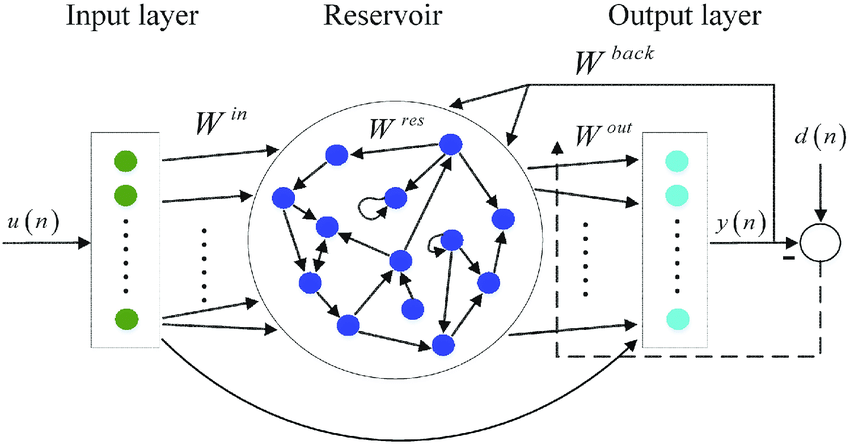Considering the convenience, some notebooks are saved in kaggle
Echo State Network is easy-to-train recurrent neural networks, a variant of Reservoir Computing. In some sense, which aims to simplify training process, reduce computation and overcome fading memory problem of RNN. In this project, the system model is designed as follow:
(1.1) Hidden Layer
where x(k) is the N-dimensional reservoir state, f is a sigmoid function (usually the logistic sigmoid or the tanh function), is the N×N reservoir weight matrix,
is the N×P input weight matrix, u(k) is the P dimensional input signal,
is the N×M output feedback matrix, and y(k) is the M-dimensional output signal.
The extended system state z(k)=[x(k);u(k)] at time k is the concatenation of the reservoir and input states. The output is obtained from the extended system state by:
where is the output activation functions (typically linear or a sigmoid) and
is a M×(P+N)-dimensional matrix of output weights.
The desired output weights are the linear regression weights of the desired output d (k) on the harvested extended states z (k), which is called as readout weights, the only learnable parameters of the reservoir computer architecture in this project:
which is an offline algorithm. Here, is the target matrix containing the
targets values for the m outputs of the reservoir computer, when inputs vectors are fed to the reservoir during
time steps.
- Numpy
- Matlplotlib (for graphing)
- tqdm
- pytorch
git clone git@github.com:LonelVino/ESN_MNIST.git
cd ESN_MNIST
pip install -r requirements.txt[1] “(PDF) An overview of reservoir computing: Theory, applications and implementations.” https://www.researchgate.net/publication/221166209_An_overview_of_reservoir_computing_Theory_applications_and_implementations (accessed Feb. 02, 2022).
[2] R. J. Williams and D. Zipser, “A Learning Algorithm for Continually Running Fully Recurrent Neural Networks,” Neural Computation, vol. 1, no. 2, pp. 270–280, Jun. 1989, doi: 10.1162/neco.1989.1.2.270.
[3] A. Lamb, A. Goyal, Y. Zhang, S. Zhang, A. Courville, and Y. Bengio, “Professor Forcing: A New Algorithm for Training Recurrent Networks,” arXiv:1610.09038 [cs, stat], Oct. 2016, Accessed: Feb. 04, 2022. [Online]. Available: http://arxiv.org/abs/1610.09038
[4] H. Jaeger, “The" echo state" approach to analysing and training recurrent neural networks-with an erratum note’,” Bonn, Germany: German National Research Center for Information Technology GMD Technical Report, vol. 148, Jan. 2001.

